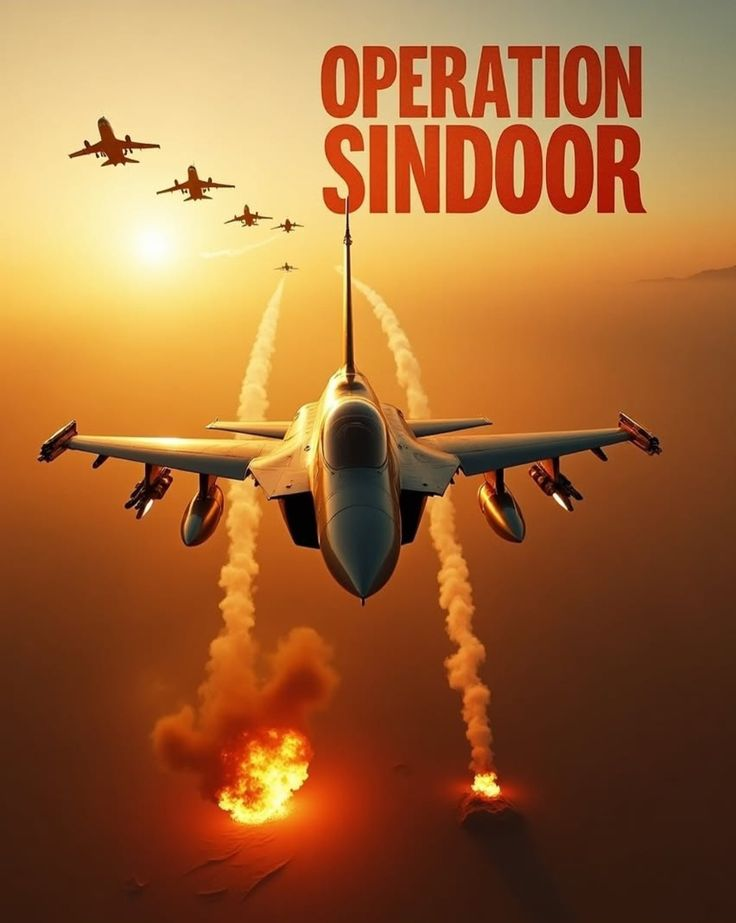Written by- Akshika Jangid
There are sunrises we watch for their beauty, and then there are sunrises that bring something more — a ray of hope, strength, and a quiet reassurance that we are safe. One such dawn arrived on a Wednesday morning, when television screens across the country flashed breaking news: “Operation Sindoor Complete – Mission Successful.”
While many of us were still asleep, our Bravehearts were wide awake guarding our border and prepared to launch the operation and finish it in a span of 25 minutes. This was not “just another surgical strike.” Operation Sindoor was a statement — a calculated, sovereign act to safeguard the border, protect civilians, and reaffirm India’s zero tolerance towards terrorism. The government’s stance was unambiguous: the objective was to eliminate terror camps without harming civilians or Pakistani military infrastructure. All actions were confined strictly to Pakistan-occupied Jammu & Kashmir (PoK) and select terrorist safe havens outside Pakistan’s formal boundaries.
The Immediate Trigger
The operation followed the Pahalgam terror attack on April 22, 2025, a cowardly assault that took the lives of 26 civilians, including tourists visiting Jammu & Kashmir. The attack reverberated across the nation, stirring grief and outrage.
In response, the Cabinet Committee on Security (CCS), chaired by Prime Minister Narendra Modi, authorized a swift military response with a single aim i.e. to neutralize the terror infrastructure responsible for repeated strikes on Indian soil.
Precision in Action
As the title of the article suggests, Operation proved India’s capacity for its Atmanirbhar defence innovation. Operation Sindoor was a joint triumph of the Indian Army, Air Force, Navy, and Border Security Force — a showcase of seamless inter-service coordination and India’s growing technological edge.
The Pakistan army had no legitimate targets to strike inside India nor did it have the courage or capability to stand up to Indian armed forces face to face.
Hence, it uses terrorism as a national policy and resorts to unmanned aerial weapons launched from its own soil. Drones and long range missiles were launched and fired from his own territory, which were his mainstay Indian military installations.
Civilian population centres including innocent ladies and children were also not spared and were considered as legitimate targets by the Pakistan military. It has even targeted religious places specifically, a case in point being the Golden Temple located in Amritsar, which is internationally renowned and a place of faith for everybody. It saw a surface of drone and missile attacks which were thwarted bravely by our Army Air Defense Gunners.
The Indian Armed forces and Army Air Defense Gunners will continue to thwart all the aerial threats coming from Pakistan.
While on the other hand, The Indian Air Force executed precision strikes using long-range standoff weapons without crossing into Pakistani airspace. India’s air defence systems, including the indigenous Akash platform, intercepted multiple Pakistani drone and missile incursions during this period. The BSF was also on high alert, especially in the Jammu region, and successfully thwarted infiltration attempts during the operation.
So the air defense role has been divided between the Army, Navy and the Air Force. While the Air Force is the primary respondent, even the Army has an important role to play in the Air Defence as it looks after the airspace and the rear areas in the Tactical Battle Area (TBA).
The operation was indeed successful in its mission as nine terror camps associated with groups like Jaish-e-Mohammed and Lashkar-e-Taiba, were targeted and completely destroyed. Among the most significant outcomes of Operation Sindoor was the elimination of high-profile terrorist leaders, including Yusuf Azhar, a key operative of Lashkar-e-Taiba. This struck a major blow to the operational command of several terror networks.
The operation also sent a strong signal to the international community and Pakistan that India would no longer tolerate acts of terrorism without a proportionate response. It marked a major doctrinal shift in India’s counter-terrorism strategy, reflecting a new policy of assured retaliation and precise targeting.
Measured Yet Uncompromising
The ceasefire, agreed upon at 5 PM IST on May 10, 2025, brought the operation to a pause. But when Pakistan violated the terms shortly afterward, India’s Foreign Secretary, Vikram Misri, issued a stern warning: India’s armed forces remained on full alert and were empowered to respond decisively to any further provocation.
What set Operation Sindoor apart was its balance — force without escalation. The strikes were decisive, proportionate, and non-escalatory, ensuring that Pakistan could not spin them into a pretext for broader conflict.
The Diplomatic and Strategic Ripple Effect
Internationally, India moved swiftly to explain the operation’s scope and rationale to global powers and strategic allies. The message was deliberate: India will retaliate against terrorism, not against people.
In a bold move, New Delhi also unilaterally terminated the Indus Waters Treaty, signaling a readiness to employ diplomatic and economic levers alongside military power.
Domestically, public sentiment was overwhelmingly supportive. Citizens saw Operation Sindoor as proof of a new national security doctrine — one that blends technology, intelligence, and political will to defend the nation.
After the operation, India’s diplomacy has shifted its strategy from traditional, unconditional agreements to a new, conditional approach. This shift signals a departure from post colonial restraint, where treaties like the Indus Water Treaty and the Simla Agreement were seen as a sacrosanct instrument. Instead, India now links treaty obligation to its counterterrorism goals essentially making cooperation conditional — very well stated in the phrase that “blood and water cannot flow together.”
A New Era – India’s Atmanirbhar Defence
The new era of strategic ambiguity and conditional cooperation has led to mutual breakdown of trust, exemplified by the erosion of these long standing agreements. This approach introduces significant instability and marks a shift from diplomacy based on trust to a more zero sum, retaliatory form of politics.
This operation was a showcase of India’s Atmanirbharta (self-reliance) in defence capabilities. Indigenous systems — from precision-strike munitions to advanced air defence platforms — enabled India to respond swiftly without external dependency.
Prime Minister Narendra Modi summed it up succinctly when he called Operation Sindoor the “new normal” — a pledge that every future act of terror would meet with direct, resolute and decisive action. Yet, as climate change and water scarcity threaten to deepen divisions, India must evolve beyond bilateral retaliation. A forward-looking step would be to embrace a multilateral framework, such as establishing a South Asian Water Council and reviving Track II Diplomacy, to rebuild trust and promote stewardship of shared resources.
Operation Sindoor was more than a military success. In military history, there are moments that mark a turning point. It will be remembered as one such moment — the dawn of a more assertive India, one that is capable of defending its people, borders, and peace with both strength and measured wisdom.








One Response
Amazing content! Keep up the great work 👍